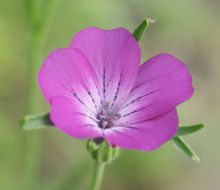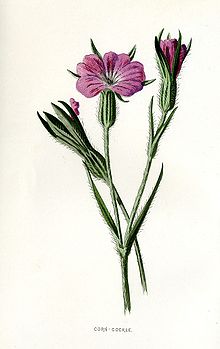- Common Corncockle
-
Common Corncockle 
Scientific classification Kingdom: Plantae (unranked): Angiosperms (unranked): Eudicots (unranked): Core eudicots Order: Caryophyllales Family: Caryophyllaceae Genus: Agrostemma Species: A. githago Binomial name Agrostemma githago
L.Common Corncockle (Agrostemma githago) - also written "corn cockle" and "corn-cockle" and known locally simply as "the corncockle" -, is a slender pink flower of European wheat fields. In the 19th century, it was reported as a very common weed of wheat fields and its seeds were inadvertently included in harvested wheat seed and then re-sown the following season. It is very likely that until the 20th century, most wheat contained some corncockle seed.
It is now present in many parts of the temperate world as an alien species, probably introduced with imported European wheat. It is known to occur throughout much of the USA and parts of Canada, parts of Australia and New Zealand.
In parts of Europe such as the UK, intensive mechanised farming has put the plant at risk and it is now uncommon or local. This is partly due to increased use of herbicides but probably much more to do with changing patterns of agriculture with most wheat now sown in the autumn as winter wheat and then harvested before any corncockle would have flowered or set seed.
It is a stiffly erect plant up to 1 metre tall and covered with fine hairs. Its few branches are each tipped with a single deep pink to purple flower. The flowers are scentless, are 25 mm to 50 mm across and are produced in the summer months - May to September in the northern hemisphere, November to March in the southern hemisphere.
Each petal bears 2 or 3 discontinuous black lines. The five narrow pointed sepals exceed the petals and are joined at the base to form a rigid tube with 10 ribs. Leaves are pale green, opposite, narrowly lanceolate, held nearly erect against stem and are 45 mm to 145 mm long. Seeds are produced in a many-seeded capsule. It can be found in fields, roadsides, railway lines, waste places, and other disturbed areas.
All parts of the plant are poisonous, but it has been used in folk medicine but there is a risk of fatal poisoning.[1]
References
External links
Categories:- Caryophyllaceae
- Garden plants
- Medicinal plants
- Poisonous plants
- Caryophyllales stubs
Wikimedia Foundation. 2010.

